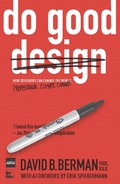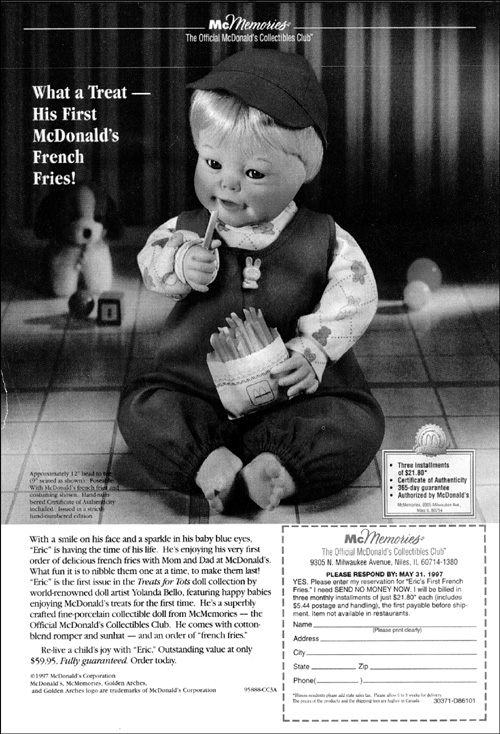
GRAPHIC DESIGN CAN BECOME more important than the product it helps promote. The products become icons for graphic memories that consumers enjoy. So as brands evolve from marks of quality to free-floating ideas products also become vectors for brand awareness.
Considering the lengths that breweries will go to great lengths to influence males aged 18 to 24, it is clear that those companies have figured out the transcendence of branding. Marketers and designers know that the beer men buy while young will likely be the beer they’ll reach for through the rest of their years.
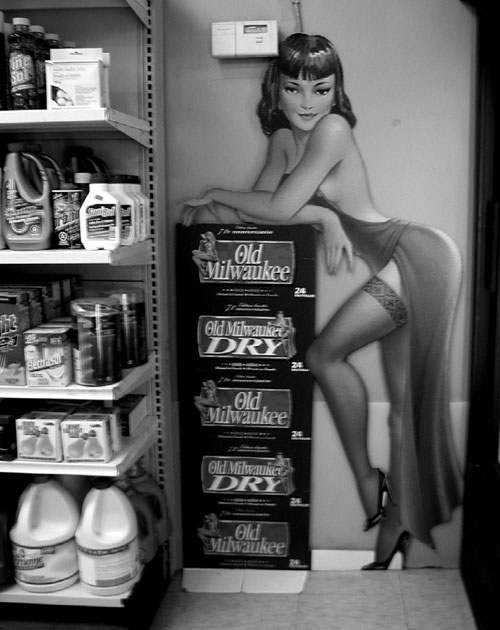
False beer cases with false hopes, corner store, Montréal
It’s a rare person who can distinguish main-stream lagers without their labels. Rather, beer manu-fac-turers exploit the fact that people use a particular beer brand to make a statement about themselves. Which bottle they choose to display at their pub table advertises something about who they are.[91]
Companies tend to brand most thoroughly those products that are most difficult to tell apart, such as bottled water, alcohol – even politicians. When there is no substantive difference, marketers manufacture a distinction. Absolut vodka is famous for seizing the U.S. vodka market with a delightful advertising campaign, out-selling bourbon in its home market. In chemical analysis, all non-traditional clear vodkas are essentially identical – as my dad demonstrated in his National Research Council lab, where he spent his entire career. Knowing that competitors would not be able to produce a higher-quality liquid, Absolut instead created this famously clever campaign, where the product becomes whatever a specific target audience takes pride in.
Corporations and marketing campaigns are changing the way we all think about our world, young and old. As I travel, I find myself explaining to people who have never spent time in North America that it is not the place depicted in advertisements or soap operas or Hollywood films. North America is not Coca-Cola, Marlboro, and KFC. We are different, diverse, greater than the sum of all products, worthy of pride. We are proud of our governance, our heritage, our history. We are proud of our innovation. But there is a lot we should not be so proud of...
Before the Joe Camel cartoon character appeared in the 1980s, Camel cigarettes had one percent of the U.S. teen cigarette market. By the time Joe was deported in 1997, Camel had 32 percent of this market,[92] and more than 90 percent of six-year-olds could recognize Joe (more than knew Mickey Mouse).[93] Is there any question that these ads were targeting youth?

The ad below contains no branding, no product shot, no benefit statement. Yet Marlboro branding is so prevalent that, typographer or not, you just need to see the font[94] to recognize the brand. Philip Morris International rolls out more than 760 billion cigarettes a year.[95] That’s almost six packs for every man, grandmother, and child on the planet.
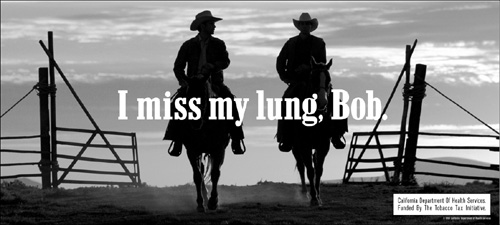
The world’s longest-running advertising campaign,[96] born in 1954, sadly will outlive most smokers
So will Big Tobacco succeed in convincing the girl using the sip-puff technology to puff cigarettes?
Lying to children is especially heinous.[97] Method-ically tricking a population that still believes in the tooth fairy in order to fulfill a greed disorder lies some-where between cowardly and despicable. And yet, U.S. advertisers spend more than $12 billion a year on messages aimed at the youth market.[98]
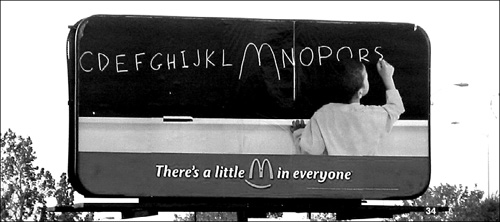
“Over 100 billion sold.”[99] The M logo was designed by Jim Schindler in 1962.
McDonald’s set out many years ago to make their letter M part of every child’s alphabet, with a specific focus on long-term marketing targeted at young children. A genera-tion later, the average weight of an American has risen over 4.5 kg (10 pounds). Consider that Americans spend 42 percent of their food budget on food served outside the home, compared to 27 percent in Canada. One-fifth of the mass of municipal solid waste in the U.S. today is food packaging,[100] while obesity kills 325,000 Americans a year – more than alcohol, drugs, firearms, and motor vehicles combined.[101]
McDonald’s marketing at naïve five-year-olds was preda-tory. A typical American child sees 10,000 food commercials a year on television,[102] sprinkled among increasingly violent TV shows designed to build brand identity: almost every cartoon show is about a product line. American children have more pocket money than the world’s half-billion poorest people,[103] and one in three American kids under six has a TV in his or her room.
“Contempt for the intelligence of the audience engenders graphics that lie?.... graphic excellence begins with telling the truth.” | ||
| --EDWARD R. TUFTE | ||
To convince children of a world full of false needs is downright cruel. Would you invite someone into your home that would lie to your kids? Of course not. So why would we invite people into our design firms and ad agencies who want us to help them trick children?
Consider that of the 111 songs that made the Billboard Top 20 of 2003 – a list biased heavily towards youth-driven pop culture – 43 had brand names within the lyrics.[104]
The age at which children recognize that advertising is not always truthful is around eight.[105] At what age will a child stop putting their tooth under the pillow for the tooth fairy? Even in the face of contradictory evidence, children will hold onto beliefs about Santa Claus for years. And there are more subtle deceptions that stick with us our entire lives.
In North America, our 10-year-olds have learned to some degree how the lying works. They build up a certain immunity, a skeptical thick skin, and prematurely lose their childhood sensitivity. The larger risks lie in larger populations rapidly embracing the worst of Western lifestyle, not only proliferating overconsumption, waste, and foreign dependence, but also undermining culture that would provide stability through times of great change.
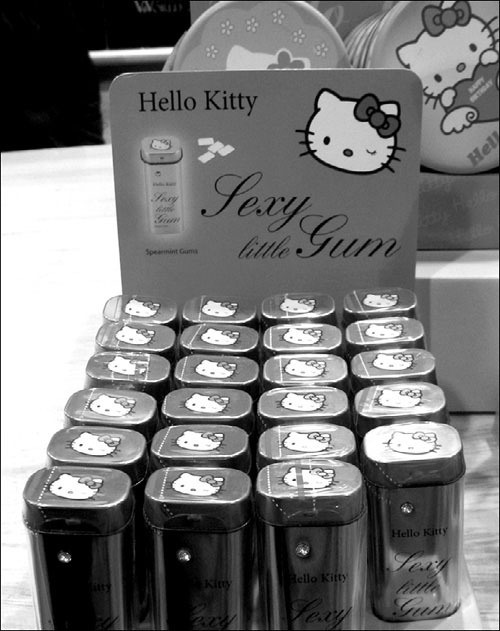
Sexualization and celebrity are changing what childhood is about

Children using Microsoft’s Windows Live Messenger (MSN) peripherally stare at ads for singles dating for hours, like the one above. Just one click on that ad and they are already engaged in a chat with an eager, mostly-naked moving female.
Bombarding young audiences with persuasive messages is additionally unethical because teenagers are so easily influenced as they desperately seek and shape their identities. Young people today are wonderfully savvy of the tactics being used against them, and yet they still remain victims.
We can do better: in the Canadian province of Québec, and the countries of weden and Norway, television advertising aimed at children is prohibited by law.[106]
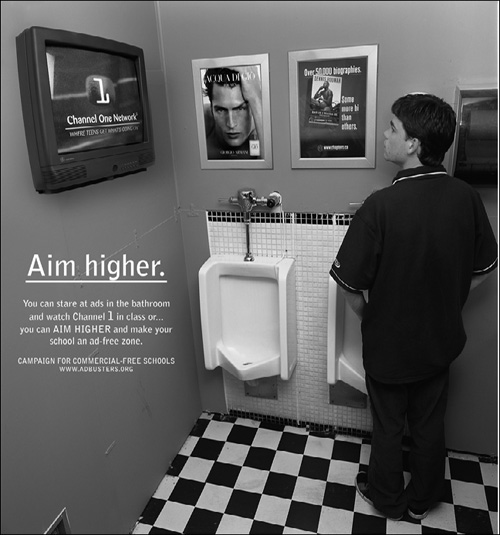
Time to reflect
By the time students reach high school, they have been socialized to expect a bombardment of marketing messaging. I recently visited my old high school and found there are now national pizza ads in the lunch area. In a vacuum of funding for the poorer U.S. schools, 8,000 principals have happily agreed to force children to watch advertising-based Channel One News in the classroom, in exchange for free television equipment. At their desks, this programming teaches kids to consume fast food, candy bars, and sports drinks. Meanwhile, in the U.S., 13 percent of schools allow fast-food chains to operate on their premises.[107]
And then our kids become college students. If the ethical argument is not compelling enough, consider the geopolitical effects of exporting confusion, inferiority, and desensitization to the parts of the world where extremist groups also offer identity options to vulnerable youths with low self-esteem. In October 2002, I was travelling in a bus to an ethics seminar for design students in Jordan about the effects of bombardment by foreign icons of success, beauty, and power. I casually counted that the people in four out of five billboards in Amman were obviously Western. These images defining success, attractiveness, and what you need to be loved and admired, are what these youth are encouraged to emulate.
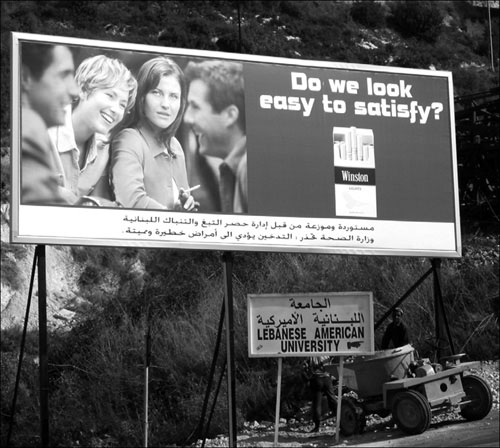
Unsatisfied Europeans and English in Byblos, Lebanon
The students reported a prevailing feeling of inferiority. One student put it this way: “We know we are behind and not as good as those people.” And I wonder to what degree this belief is learned from a lifetime barrage of such imagery. Such marketing plays on the relative naïveté of Developing World cultures as much as it plays on the higher vulnerability of a child who has not grown up in a culture of visual deceit. The Jordanian youth are, admirably, not socialized to be victims of visual lies.
Anna, a designer who had immigrated to Canada from pre-democratic Poland, came to work at my design studio. One day she received a Publishers Clearing House sweepstakes letter at her home, explaining in colorful detail how she apparently had just won over $1 million. She was under-standably bouncing off the walls in excitement until her Canadian partner arrived home to give her the sobering, humiliating news that no, that’s just a very fancy deception that we are all accustomed to here in North America. There are so many lies within our socialization, that we don’t even notice them anymore. How much does that thick skin cost our society? And what are we getting in return?

Macau is being transformed into an offshore gambling haven for over a billion Chinese in whose country gambling is against the law. I’ve never seen so many cranes in one place.
As adults, we find it often impossible to break habits, especially those learned early on. Advertisers take advantage of weaknesses in our psyche to convince us of false needs that can be satisfied by buying things. Good design should be about what’s good about the product, not what is “bad” or vulnerable in the buyer.
The slot machine is an ingenious piece of industrial design that assists in the triumph of the greedy over the vulnerable. The device hugely magnifies a combination of subte weaknesses in the human decision-making schema – a schema which works excellently for mammals in the natural wild, but is dangerously lacking in an artificial urban world. The effect is amplified by an eerily satisfying mixture of feedback many cannot ignore. The resulting methodical corruption of judgment often destroys the hopes and dreams of individuals and their families, creat-ing poverty and crime. Even more troubling, our acceptance addicts governments to a carcino--gen of unnatural profit. And so, rather than regu-lat-ing safer entertainment, government enjoys reaping regressive gambling taxes, spending just enough on a public display of brochures and hotlines to suggest that the situation is under control.

Tokyo: Is this how we want our children spending their days and their earnings? Fulfilling primeval urges to hunt and gather through habituated shopping can be just as intense.
Shopping is more subtle than gambling, but no matter how logical I believe my buying decisions to be, beloved radio jingles are still in my head from when I was five years old.
Similarly, the seed for the success of the subprime mortgage sales pitch was planted decades ago. As children, we were taught by our own society that bankers teach us how to save, and to rely upon them to be more cautious with our money than our own risk impulses would typically dictate.
Does giving up our sense of smell make us lose our sense of right and wrong?
We have become so accustomed to the association of perfume and sex in advertising that it no longer registers as unnatural. My tweenage nephews are now wearing Axe cologne. I’m not sure if they know why. They are being trained that wearing (or perhaps just purchasing) false pheromones will yield passionate intimacy and Hollywood hair. In the West, perfumes and sexual imagery are so linked that the very notion of how we are supposed to experience emotional and physical intimacy are defined for us by advertisers.
“And when did the fine art of perfumery go from being about taboo, love potions and sorcery to Bill Blass, Christian Dior and Ralph Lauren?” | ||
| --TOM ROBBINS, IN JITTERBUG PERFUME | ||

What would Maslow do?

Calvin Klein goes beyond creating personas, giving these fictions e-mail addresses
I wonder if those young men will ever be able to experience sexuality without the overlays taught by print, television and the Internet. (It would be as difficult as seeing Harry Potter as you had imagined him while reading, before you’d seen the movie of the book.)
Must their first kiss be a Kodak Moment? Can we not own our own intimacy? I do not want to think about Calvin Klein when I am making love – do you? The natural, evolutionary link between our sense of smell and mating behaviors has become horribly contorted by the forces of greed. The social profit-and-loss statement on this transaction is unlikely to be in society’s favor.
What drives all this energy and motivation to create ever-larger mechanisms to convince our most vulnerable to choose behaviors clearly not in their best interests, nor in the best interests of our species?
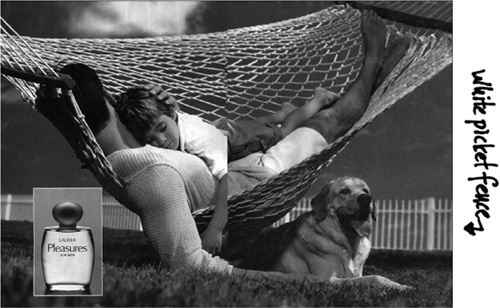
You can have a balanced life. But cologne won’t give it to you. Disney’s Mickey Eisner coined the term “branded experience,” as something to be sought out.
Greed for resources. Greed for power. More resources and power than any one person or family could ever really make use of. It’s simply an unfortunate aberration: the drive behind such greed is a healthy instinct shared by all mammals, coupled with a healthy pushback from a natural environment that is uncompromising in its power. But evolution was not prepared for a species to come along and blow past the assumed limits: a species that figured out how to rearrange the resources so that this drive could be so grandly and regularly overfulfilled. The unfortunate result: a society caught up in seeking more rather than enjoying what we have; a society that often celebrates success by what we can acquire rather than what we do.

“Are you as clean as you think you are?” Typographic excellence boldly questioning self-esteem.
Advertising and design change how youth behave and think. Do you really want to spend the best years of your career spreading misery and feelings of inadequacy? Encouraging addictions? Destroying hopes and dreams? Perhaps it is designers who should be changing their thinking instead.
Let’s not just help turn the ship around while there is still time. Let’s ask ourselves who is at the helm and why we let them lead. Is our ship being steered by a great philosophical vision, or has it simply been hijacked by a natural mammalian tendency, artificially magnified beyond reason or value?

Does enough integrity exist among designers and marketers that we can volunteer to help navigate?
Society wisely confers conspicuous power and stewardship to professional groups. Designers have a disproportionately large influence in these three areas:
How messages intended to influence the behavior of large audiences are selected, crafted, and delivered
How people are portrayed and represented visually
How raw materials for designed objects (such as the paper for this book) are consumed
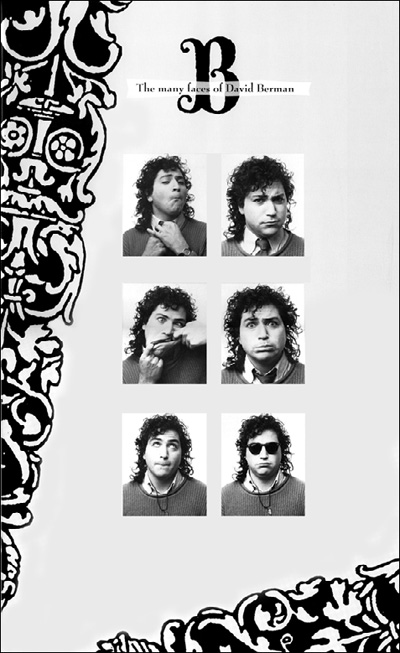
The Many Faces of David Berman typeface catalogue, David Berman Typographics, 1989
Are designers behaving in a way that encourages society to fully entrust us with such stewardship?
Once upon a time, all I cared about what has how good the typography was. One day I realized that, no matter how well I perfect the spacing of a headline, if the words won’t fulfill the client’s strategy, my effort is pointless. But the larger news hit me later: if that message is counterproductive to the larger strategy of a sustainable world, then my effort is also irresponsible.
I hope that I’ve made this message clear: the biggest issue of our day is the environment; overconsumption is driving its destruction; overconsumption is fueled most powerfully by clever visual arguments to convince everyone (including larger, growing Developing World populations) to consume more and more. Our impact as designers and as consumers of design is huge. We should be held responsible.
